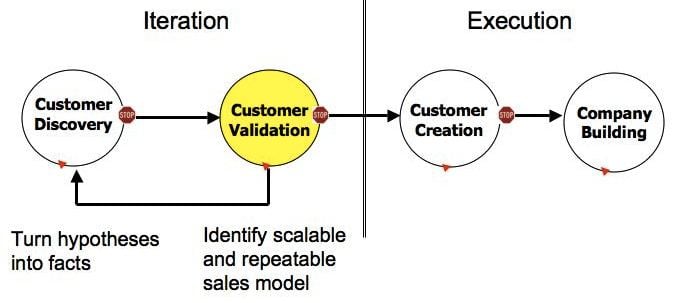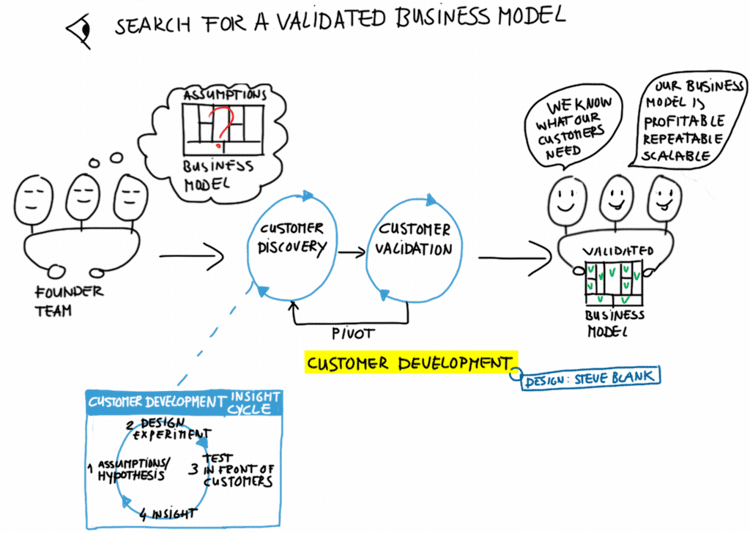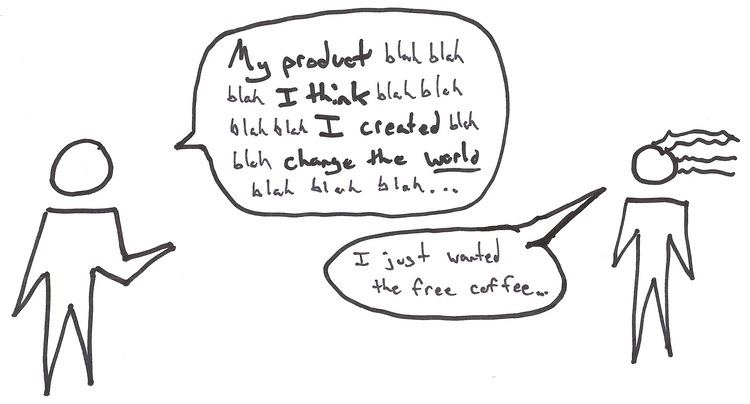 | ||
The customer development process 2 minutes to see why
Customer Development is a formal methodology for building startups and new corporate ventures. It is one of the three parts that make up a Lean Startup (Business Model Design, Customer Development, Agile Engineering).
Contents
- The customer development process 2 minutes to see why
- Steve blank on customer development the second decade
- History
- The Four Step Process
- Customer Development Manifesto
- Teachings
- Business Model
- Business Model Canvas
- Minimum Viable Product
- Hypotheses
- Pivot
- References

The process assumes that early ventures have untested hypotheses about their business model (who are the customers, what features they want, what channel to use, revenue strategy/pricing tactics, how to get/keep/grow customers, strategic activities needed to deliver the product, internal resources needed, partners needed and costs.). Customer Development starts with the key idea that there are no facts inside your building so get outside to test them. The hypotheses testing emulates the scientific method – pose a business model hypothesis, design an experiment, get out of the building and test it. Take the data and derive some insight to either 1) Validate the hypothesis, 2) Invalidate the Hypothesis or 3) Modify the hypothesis.

Many burgeoning startup companies devote all of their efforts to designing and refining their product and very little time “getting out of the building.” The customer development model encourages that more time be spent in the field identifying potential consumers and learning how to better meet their needs. The Customer Development concept emphasizes empirical research.

Customer Development is the opposite of the “if we build it, they will come” product development-centered strategy, which is full of risks and can ultimately be the downfall of a company.

The Customer Development method was created by serial entrepreneur-turned-educator Steve Blank, father of the Lean Startup movement. According to Blank, startups are not simply smaller versions of larger, more developed companies. A startup operates in a fashion vastly different from that of a large company and employs different methods. While larger companies execute known and proven business strategies, startups must search for new business models. Customer Development guides the search for a repeatable and scalable business model.

Steve blank on customer development the second decade
History

Customer Development was developed by serial entrepreneur Steve Blank in the 1990s. While writing about his experiences as an entrepreneur in the Silicon Valley for his memoir, Blank began to notice patterns in the startups he was involved with. Recognizing that startups are not simply smaller versions of large companies, he observed that entrepreneurs need to have a systemized approach to guide their search for “repeatable and scalable business models.”
The revelation led to his first book, The Four Steps to the Epiphany: Successful Strategies for Products that Win, which served as the course text for his first class and heralded the birth of Customer Development, which in turn spawned the Lean Startup movement.
Blank’s second book, The Startup Owner’s Manual, is a step-by-step guide to building a successful startup using Customer Development principles.
The Four-Step Process
The Customer Development method consists of four steps that are designed to help avoid common pitfalls and repeat successful business strategies:
Customer Development Manifesto
The Customer Development Manifesto from The Startup Owner’s Manual, written by Steve Blank and Bob Dorf:
- There Are No Facts Inside Your Building, So Get Outside
- Pair Customer Development with Agile Development
- Failure is an Integral Part of the Search for the Business Model
- If You’re Afraid to Fail, You’re Destined to Do So
- Iterations and Pivots are Driven by Insight
- Validate Your Hypotheses with Experiments
- Success Begins with Buy-In from Investors and Co-Founders
- No Business Plan Survives First Contact with Customers
- Not All Startups Are Alike
- Startup Metrics are Different from Existing Companies
- Agree on Market Type – It Changes Everything
- Fast, Fearless Decision-Making, Cycle Time, Speed and Tempo
- If it’s not About Passion, You’re Dead the Day You Opened your Doors
- Startup Titles and Functions Are Very Different from a Company’s
- Preserve Cash While Searching. After It’s Found, Spend
- Communicate and Share Learning
- Startups Demand Comfort with Chaos and Uncertainty
Teachings
Blank’s Customer Development method has changed the way entrepreneurship is taught. He began teaching Customer Development in his entrepreneurship classes at Stanford University and UC Berkeley. His class, the Lean Launchpad, was first taught has been adopted by more than 75 universities around the globe. In 2011, Blank’s curriculum became the new standard for science commercialization in the U.S. as the National Science Foundation adopted it for their Innovation Corps.
A free online version of the course focusing on customer feedback and early market testing has been offered since the beginning of 2012. It is designed for all types of entrepreneurs and requires them to have a viable business concept written by the end of eight weeks. The course has more than 300,000 registered users.
As of 2016, with the launch of two new classes—Hacking for Defense and Hacking for Diplomacy - Blank’s Lean LaunchPad methodology has also revolutionized how the U.S. defense and intelligence community and State Department can deploy innovation with speed and urgency.
Business Model
From the Customer Development view, a business model is a representation of how organizations create, deliver and capture value. It is designed to change rapidly, reflect customer reality and iterate as new information is discovered.
The business model is based on the mantra, “No business plan survives first contact with customers.” The business plan is an operating document that existing companies write to execute known business models. However, for a startup, there are too many unknowns to develop a successful plan. The static business plan necessarily changes as soon as the business comes in contact with its target market.
Startups are involved in searching for the right business model. The business model is tested in the real world (e.g., through a Minimum Viable Product) to gather customer input and make necessary changes. When a successful, repeatable business model is discovered, the company enters the product execution and business plan phase.
Business Model Canvas
Alexander Osterwalder and Yves Pigneur designed the Business Model Canvas. The Canvas is a tool to help entrepreneurs structure and plan their business models. It is designed to change rapidly, highlight alternatives, promote a customer focus and encourage testing. It can also be used to set up Customer Development hypotheses and to visually track iterations.
The Business Model Canvas is made up of nine blocks:
Osterwalder and Blank have integrated both business model design and Customer Development hypotheses into the Business Model Canvas. Each of the nine blocks corresponds to one or more Customer Development hypotheses. When a hypothesis is found to be incorrect, entrepreneurs can apply Customer Development strategies to turn the mistake into a Pivot. As a Pivot, a failed hypothesis becomes a learning strategy, and the business model can be rewritten.
Minimum Viable Product
The Minimum Viable Product (MVP) is “that version of a new product which allows a team to collect the maximum amount of validated learning about customer with the least effort.” The startup releases the most minimal, core product to start testing early and minimize the total development process time.
The MVP allows entrepreneurs to gather feedback from early adopters to prevent pitfalls and avoid building unwanted products. The MVP also lets customers point out missing features and necessary changes.
To successfully use the MVP strategy, entrepreneurs must be committed to iteration. Customer feedback will bring the product or service through several changes before it is finalized.
Hypotheses
Hypotheses are critical assumptions about how a business will work, and include assumptions about target market, pricing, and competitors. Together, hypotheses make up the business model for a startup.
Testing hypotheses means that the founder has to “get out of the building” and answer three questions about the business:
- Do we really understand the customer’s problem or need?
- Do enough people care about the problem or need to deliver a huge business?
- Will they care enough to tell their friends and grow the business quickly
Hypotheses can be tested in several ways. Creating a Minimum Viable Product is one way to quickly test mockups and ideas in the real world, especially with Web and mobile startups.
Hypotheses change as a result of testing and customer feedback. The changed hypotheses are incorporated into new iterations of the startup business model.
Pivot
The Pivot is “a structural course correction to test a new fundamental hypothesis about a product, strategy [or] engine of growth.” It is the process of changing a part or parts of the business model to reflect reality.
The Customer Development process assumes that most of the initial assumptions of the business model will be wrong. Pivoting involves recognizing that the original business model is not working, then deciding what changes to make and taking action on those changes. This process is easier to visualize when the business model is drawn out.
White iterating involves small changes like altering a product price, pivoting involves substantial changes like identifying a better target market. The process involves four steps:
- Observe: Observing that the business model isn’t working.
- Orient: Orienting to the new facts.
- Decide: Deciding what to change in the business model.
- Act: Acting decisively to make the change.
There are several examples of successful companies that pivoted early on, including Groupon, which famously Pivoted from a failed social advocacy campaign into a billion dollar daily deal site, and Fab.com, which pivoted from a social network to a daily deal design site. Instagram pivoted from a mobile microblogging platform into a photo application.
